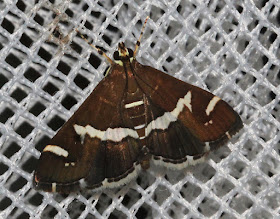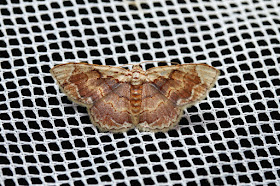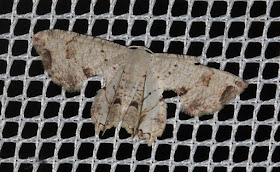Allen Sundholm conveyed this image of a Jewel Beetle Castiarina maculicollis found by Robert Richardson near Goonoo Goonoo, New South Wales.
 |
| Castiarina mculicollis A. Sundholm photo |
This beetle appears to be a classic example of
Mullerian Mimicry. The beetle resembles at least three species of diurnal cockroaches in the genus
Ellipsidion. The geographic range of the beetle coincides with that of the cockroaches.
Ellipsidions are cockroaches that look like anything but cockroaches. They are gaudy, brightly coloured and active mostly during the day. Their bright colours and patterns stand out. They can frequently be found on flowering plants such as Eucalyptus, Acacia or smaller shrubs and forbs. The beetle is also active during the day and Jewel Beetles frequently found on flowers.
The cockroaches mingle with the bees, wasps, beetles and other insects that visit the flowers. Insects with bright orange colours, such as those found in coccinellid beetles (lady beetles), cantharid beetles some flies and a host of moths are avoided by vertebrate predators such as lizards and birds. Chemicals incorporated in the bodies of these insects render them toxic. Young birds quickly learn to avoid lady beetles, for example, after their first encounter.
The Castiarina beetle seems to be uncommon (personal suggestion by A. Sundholm). This is one of the defining features of a Mullerian Mimicry system. That is, several members are toxic and a few others are not toxic but present in numbers much less than those of the others. If the non-toxic examples became more common than those that are toxic, the scheme would not work.
Of course, the geographic ranges of model and mimic have to overlap at some stage otherwise what is the point? In the case of the Castiarina beetle, it has been found in inland New South Wales, the Australian Capital Territory and Queensland. One of the Ellipsidion cockroaches, the Western Ellipsidion, E. australe Saussure has a fairly broad range extending across the top of Australia from the Northern Territory across to Cape York, central and southern Queensland, New South Wales and Victoria Rentz, 2014. Therefore, several of these cockroaches overlap in their distributions with that of the beetle.
Here are some examples of the cockroaches:
Ellipsidion australe Saussure
This species seems the closest match to the beetle. Note the dark legs and the antennae, the latter of which are black to the tip. C. Rowan photo
This is the Beautiful Ellipsidion
Ellipsidion simulans Hebard. Note the antennae that are lighter towards the tip. This apparently gives the allusion that the antennae are shorter than they really are. The yellow cerci and reddish legs are not shared with the beetle.
Common Ellipsidion
Ellipsidion humerale Hebard, or, perhaps, an undescribed species. This cockroach has the more pronounced difference in the antennae but lacks the dark spot present in the centre of the thorax found on the beetle and other roaches. The yellowish cerci are not shared by the beetle. D. Knowles photo
Tableland Ellipsidion
Ellipsidion gemmiculum Hebard is a small species, often found in numbers feeding on grass seed heads during the day in full sunlight. It has few characters shared with the beetle.
To a vertebrate predator on the move the range of colours and patterns in Ellipsidion might just be a reinforcement to move on and avoid these orange critters, large and tempting that they may be but they could result in an unpleasant episode.
Thanks to Allen Sundholm and Robert Richardson and D. Knowles and C. Rowan for the photos which can also be seen in the Cockroach Guidebook.
Literature
Rentz, DCF 2014. A Guide to the Cockroaches of Australia. CSIRO Publications, Pp. 1-318, Collingwoood, Vic.,





















































